Plain Grove Fen, Lawrence County, PA
June 09, 2009. Carl
Harting and I (Ed Frank) visited three sites in western
Pennsylvania on Tuesday.
These were Wolf Creek Narrows Natural Area, Hogg Woods,
and Plain Grove Fen.
I will post each portion of the trip separately
to better organize the information.
The third site we visited on this day was one called Plain Grove
Fen. It was
certainly the most spectacular site and the one where we spent
the most time. The
location was one told to Carl by a local forester.
On a previous trip Carl told me he had found a number of
large oaks, so I was psyched for the excursion.
This site is located just a few miles west of the others
in adjacent Lawrence County.
I consists of a hilltop and hillside forest growing above
a wetland area.
After returning home I looked up the
Lawrence County Natural Heritage Inventory document prepared by
the Western Pennsylvania Conservancy.
http://www.naturalheritage.state.pa.us/CNAI_PDFs/Lawrence%20County%20NAI%202002.pdf
This document (31 MB) contained
a brief description of the wetland:
Plain Grove Wetlands BDA
Plain Grove wetland rates as one of the most significant
wetlands in Lawrence County
both in terms of its rarity and overall quality. The wetland
area hosts a complex of
seepages and fens with fourteen plant species of special
concern, including a globally rare plant species….Surrounding
uplands feature young forests with canopy species typically
including white oak (Quercus
alba) and red oak (Quercus
rubra) with young black cherry (Prunus
serotina), hawthorn (Crataegus
spp.) and an understory of American hornbeam (Carpinuscaroliniana)
and dogwood (Cornus
florida). Other low abundance species present are red
maple (Acer rubrum),
black gum (Nyssa
sylvatica) and green ash (Fraxinus
pensylvanica).

This was not exactly what we found.
Instead of a young forest with smaller trees, the site
contains a large number of large oaks and sugar maples of some
age.
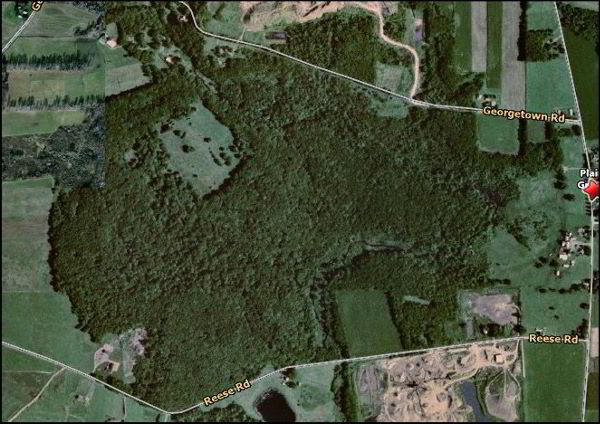
The area we visited is located in the upper portion of this
aerial photo of the overall site.
We parked near the outlet of the mine haul road and
headed into the woods from along the road a few hundred yards
west of where we parked.
Immediately we encountered a large tree.
It was a white oak snag still standing 81 feet tall with
a girth of 13 feet, just below the roadway.
It was one of several large white oaks and a black oak we
measured in that immediate area.
The rest or these trees seemed to be in good health. A
short distance farther down the slope we encountered another
semi-snag. This time it was a sugar maple with a pom-pom of
leaves still growing on its uppermost limb.
The tree was 10 feet in girth, and 85 feet tall.
There were swampy areas near the base of the slope filled
with black mud and skunk cabbage.
We worked our way through stepping on downed branches and
dryer areas until we reached the stream at the bottom of the
hill.
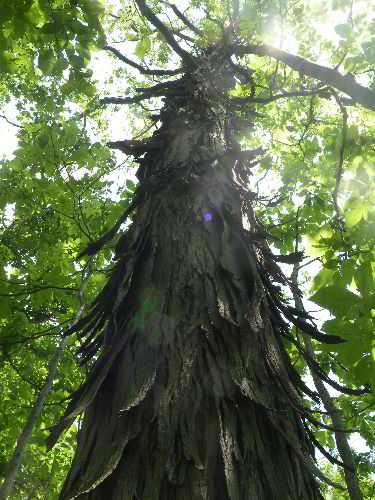
Shagbark Hickory, 7.9 feet girth, 87 feet tall. There is a
colony of bees living in a knot hole about 15 feet up this
tree. – photo by Edward Frank

Carl Harting measuring a large oak – photo by Edward Frank
This was a shallow free flowing stream perhaps 20 feet wide with
a cobble bottom. It
flows to the south into
a larger stream and its adjacent wetland.
There was a modest sized American beech growing along the
stream banks and leaning over the stream itself.
I straddled it to measure a girth, and Carl waded into
the stream to get a height.
He said it was the first time he had ever measured a tree
while standing in a stream.

Looking up large sugar maple at top of stream bank – photo by
Edward Frank
On the far side of the stream on the edge of the stream bank was
the first of many large sugar maples we encountered.
This was a magnificent specimen standing 92 feet tall
with a girth of 10.8 feet. The
trunk of the tree showed a high degree of balding and had
numerous bumps. From
this tree we could see many more large trees extending up the
slope and to both the left and right.
Carl said the forest did not extend very much farther to
the right (west) so we headed that way.
We kept encountering large sugar maples as we kept
working westward. I
measured a modest sized black cherry here, the largest we had
encountered, yet as a precaution in case those in the rest of
the site we smaller.
Little did I know that I did not need that precaution.
Eventually we reached the end of most of the big trees
and headed farther upslope and back to the east.
Up at the top I could see a large tree with a different
kind of bark pattern.
Once we reached the tree it could be seen that is was a
large double trunk elm.
Neither Carl not I am sure what species.
It was located at the edge of the open patch filed that
can be seen in the west central portion of the aerial photo of
the site. One trunk was
9.2 feet in girth, the other was 7.1 feet in girth. The
best height we could get was 81.5 feet.
Continuing generally southeastward we continued to encounter
good sized trees.
We found some larger black cherry trees, more sugar maples, a
triumvirate of bigtooth aspen, and even a stray spruce tree that
had escaped into the wood.
One tree that piqued my curiosity was a sugar maple with
pronounced ribs extending along the length of the trunk.
I am not sure why this feature develops.
It is as if the surface root bases extend up the side of
the tree.
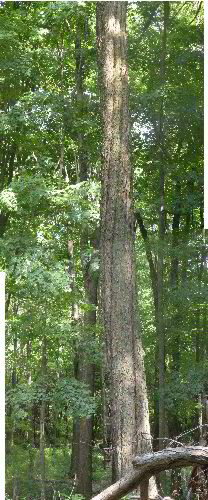
Sugar Maple with ribs – photo by Edward Frank
This maple was growing at the edge of a small opening formed by
a fallen tree.
Below this area at the flood plain level was a cluster of
smaller trees. It
was an easily recognizable patch of hawthorn tree.
We hadn’t measured any yet, so we headed down to look at
the patch. Growing
among the hawthorns were several overgrown apple trees.
I often see this association between the two species.
I am not sure if it just a coincidence because hawthorns
frequently colonize old fields or if there is something more
that promotes this association.
From here we headed back up the hill and farther into the site
looking for the large oaks Carl remembered from the previous
trip. One strange
aspect of the forest here were the species in the understory.
There were cherries, some beech sugar maples, a few oaks,
hickory, and cucumber tree.
Of these trees hickory of any kind was very uncommon in
the canopy compared to the numbers
that were shrub sized.
Even though I was watching for it, and Carl was also, I
could not find any cucumbertrees in the canopy.
They have a very distinctive look and should jump out at
you if you are looking for them.
We did find more oaks and some respectable shagbark
hickories farther into the site.
We eventually came to an area where the large tress were
absent and headed back.
The lower slope of the valley wall was brushy in this
area father downstream so we walked along the valley rim
exploring this new section.

Black Cherry, 10.1 feet girth, 102 feet tall - photo by
Edward Frank
One of the best finds here was a large black cherry, 10.1 feet
in girth and 102 feet tall.
At last one to match the oak and sugar maple we had
found. We measured
a couple more large oaks in the region, off in the distance I
could see a tree with large leaves.
Was this a big cucumbertree as I had been searching for?
As we approached, it turned out that this was a double
trunked basswood.
The larger of the two twin trunks was 6.2 feet in girth;
the other was 5.9 feet in girth.
The tree was 83 feet tall.
This is not as great of a height as an earlier basswood
measured, but it was overall a much bigger tree.
Soon we were back in an area we had previously explored, we
headed down slope and decided to cross the stream farther
downstream near the hawthorn patch.
This was a chance to see
a slightly different area of the woods.
Along the stream bank was a lone black willow.
It was not a species we had encountered anywhere else.
I was measuring its height from across the stream, when I
heard a splashing.
Carl was wading across the shallow stream to measure a girth.
Well we had to cross the stream there anyway.
From here it was a short distance across the valley
floor and up the other side to reach the road where we had
started. It turned
out the beech we measured when first crossing the stream was the
largest we encountered on the trip.
The safety black cherry I measured turned out not to be
needed. Walking
along the road back to the vehicles there were a couple of
cucumbertrees on the north side of the highway and some shingle
oaks. The latter
were not found in the area we explored.
|
Plain Grove Fen
|
|
|
|
|
Species
|
CBH (ft)
|
Height
|
|
|
White Oak
|
12.5
|
81
|
dead snag
|
|
Shagbark Hickory
|
7.9
|
87
|
|
|
Black Oak
|
9.9
|
75
|
|
|
White Oak
|
12
|
90.5
|
|
|
White Oak
|
11.7
|
95.5
|
|
|
Sugar Maple
|
7.3
|
50
|
|
|
Sugar Maple
|
10
|
85
|
snag- almost dead
|
|
Hophornbeam
|
1.6
|
50
|
|
|
Bitternut Hickory
|
6.1
|
87
|
|
|
Black Oak
|
9.5
|
90
|
|
|
Hornbeam
|
1.4
|
35
|
|
|
American Beech
|
5.8
|
61.9
|
along stream
|
|
Sugar Maple
|
10.8
|
92
|
|
|
Basswood
|
4.1
|
83.5
|
|
|
Sugar Maple
|
10.6
|
84
|
|
|
Sugar Maple
|
8.4
|
97
|
|
|
Black Cherry
|
4.7
|
81
|
|
|
Sugar Maple
|
9.1
|
92
|
|
|
Red Oak
|
7
|
98
|
|
|
Elm
|
9.2
|
81.5
|
double second girth 7.1 ft.
|
|
Black Cherry
|
5.9
|
100
|
|
|
Red Oak
|
8.9
|
105
|
|
|
Red Oak
|
8.6
|
102
|
|
|
Black Cherry
|
8.3
|
101
|
|
|
Black Cherry
|
8.4
|
109.5
|
|
|
Sugar Maple
|
8.4
|
105
|
|
|
Red Maple
|
6.9
|
96
|
|
|
Apple
|
4.5
|
40
|
|
|
Hawthorn (sp)
|
2.5
|
25
|
|
|
Black Cherry
|
8.6
|
97
|
|
|
Aspen, Bigtooth
|
3.2
|
90
|
|
|
Aspen, Bigtooth
|
2.7
|
88
|
|
|
Aspen, Bigtooth
|
3.4
|
90
|
|
|
Sugar Maple
|
9.8
|
80.5
|
|
|
Black Oak
|
9.8
|
104
|
|
|
Red Oak
|
10.8
|
114
|
|
|
White Oak
|
8
|
114.5
|
|
|
Red Oak
|
9.9
|
110.5
|
|
|
Shagbark Hickory
|
5.7
|
105
|
|
|
White Oak
|
6.2
|
101
|
|
|
Red Oak
|
10.5
|
113
|
|
|
White Oak
|
8
|
114
|
|
|
Shagbark Hickory
|
6.3
|
98
|
|
|
Basswood
|
3.8
|
90.5
|
|
|
White Oak
|
6.3
|
96
|
|
|
Black Cherry
|
10.1
|
102
|
|
|
Black Oak
|
11.9
|
102
|
|
|
Red Oak
|
11.4
|
110
|
|
|
Shagbark Hickory
|
6.6
|
108
|
|
|
Red Oak
|
13
|
108.5
|
|
|
Basswood
|
6.2
|
83
|
double second girth 5.9 ft.
|
|
Black Cherry
|
9.9
|
102
|
|
|
Red Maple
|
7.3
|
92
|
|
|
Black Willow
|
4.1
|
44.6
|
along stream
|
Looking at the data we measured 17 different species of tree.
We measured 12 trees over 10 feet in girth, representing
five different species, with several more trees and species just
short of the 10 foot barrier.
|
Plain Grove Fen
|
|
|
|
|
Species
|
CBH (ft)
|
Height
|
|
|
Red Oak
|
13
|
108.5
|
|
|
White Oak
|
12.5
|
81
|
dead snag
|
|
White Oak
|
12
|
90.5
|
|
|
Black Oak
|
11.9
|
102
|
|
|
White Oak
|
11.7
|
95.5
|
|
|
Red Oak
|
11.4
|
110
|
|
|
Sugar Maple
|
10.8
|
92
|
|
|
Red Oak
|
10.8
|
114
|
|
|
Sugar Maple
|
10.6
|
84
|
|
|
Red Oak
|
10.5
|
113
|
|
|
Black Cherry
|
10.1
|
102
|
|
|
Sugar Maple
|
10
|
85
|
snag- almost dead
|
The Rucker Height Index for the site was not that high at
101.85. Given the
large numbers of fat trees I also calculated a Rucker Girth
Index of 9.5
|
Plain Grove Fen
|
|
|
|
|
Species
|
CBH (ft)
|
Height
|
|
|
White Oak
|
8
|
114.5
|
|
|
Red Oak
|
10.8
|
114
|
|
|
Black Cherry
|
8.4
|
109.5
|
|
|
Shagbark Hickory
|
6.6
|
108
|
|
|
Sugar Maple
|
8.4
|
105
|
|
|
Black Oak
|
9.8
|
104
|
|
|
Red Maple
|
6.9
|
96
|
|
|
Basswood
|
3.8
|
90.5
|
|
|
Aspen, Bigtooth
|
3.4
|
90
|
|
|
Bitternut Hickory
|
6.1
|
87
|
|
|
Rucker Height Index
|
101.85
|
|
|
|
|
|
|
|
Elm
|
9.2
|
81.5
|
double second girth 7.1 ft.
|
|
American Beech
|
5.8
|
61.9
|
along stream
|
|
Hophornbeam
|
1.6
|
50
|
|
|
Black Willow
|
4.1
|
44.6
|
along stream
|
|
Apple
|
4.5
|
40
|
|
|
Hornbeam
|
1.4
|
35
|
|
|
Hawthorn (sp)
|
2.5
|
25
|
|
|
|
|
|
|
|
|
|
|
|
|
Plain Grove Fen
|
|
|
|
|
Species
|
CBH (ft)
|
Height
|
|
|
Red Oak
|
13
|
108.5
|
|
|
White Oak
|
12.5
|
81
|
dead snag
|
|
Black Oak
|
11.9
|
102
|
|
|
Sugar Maple
|
10.8
|
92
|
|
|
Black Cherry
|
10.1
|
102
|
|
|
Elm
|
9.2
|
81.5
|
double second girth 7.1 ft.
|
|
Shagbark Hickory
|
7.9
|
87
|
|
|
Red Maple
|
7.3
|
92
|
|
|
Basswood
|
6.2
|
83
|
double second girth 5.9 ft.
|
|
Bitternut Hickory
|
6.1
|
87
|
|
|
Rucker Girth Index
|
9.5
|
|
|
|
|
|
|
|
|
|
|
|
|
|
American Beech
|
5.8
|
61.9
|
along stream
|
|
Apple
|
4.5
|
40
|
|
|
Black Willow
|
4.1
|
44.6
|
along stream
|
|
Aspen, Bigtooth
|
3.4
|
90
|
|
|
Hawthorn (sp)
|
2.5
|
25
|
|
|
Hophornbeam
|
1.6
|
50
|
|
|
Hornbeam
|
1.4
|
35
|
|
We had only had a handful of RGI’s calculated so I have little
with which to compare this number.
Still is seems to me that it is a good number for this
single site.
Edward Frank
Here are a few more shots I took from Plain Grove Fen:

Carl
with large oak
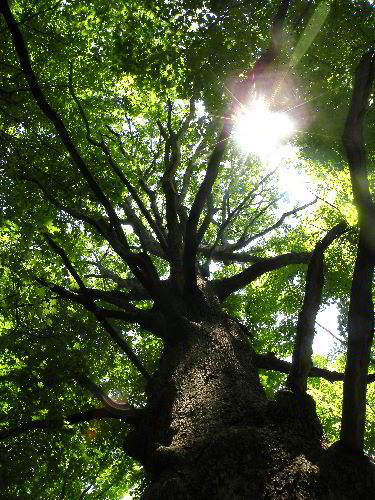
looking
upward in a large oak
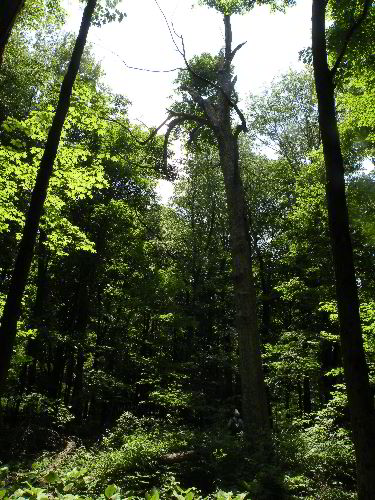
Sugar
maple almost-snag with a puff of live leaves at the top

Hawthorn
and apple grove
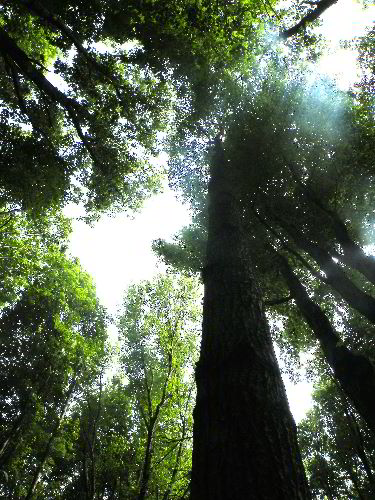
looking
up a black oak
 Bees in knothole in large Shagbark Hickory
Bees in knothole in large Shagbark Hickory
Continued at: